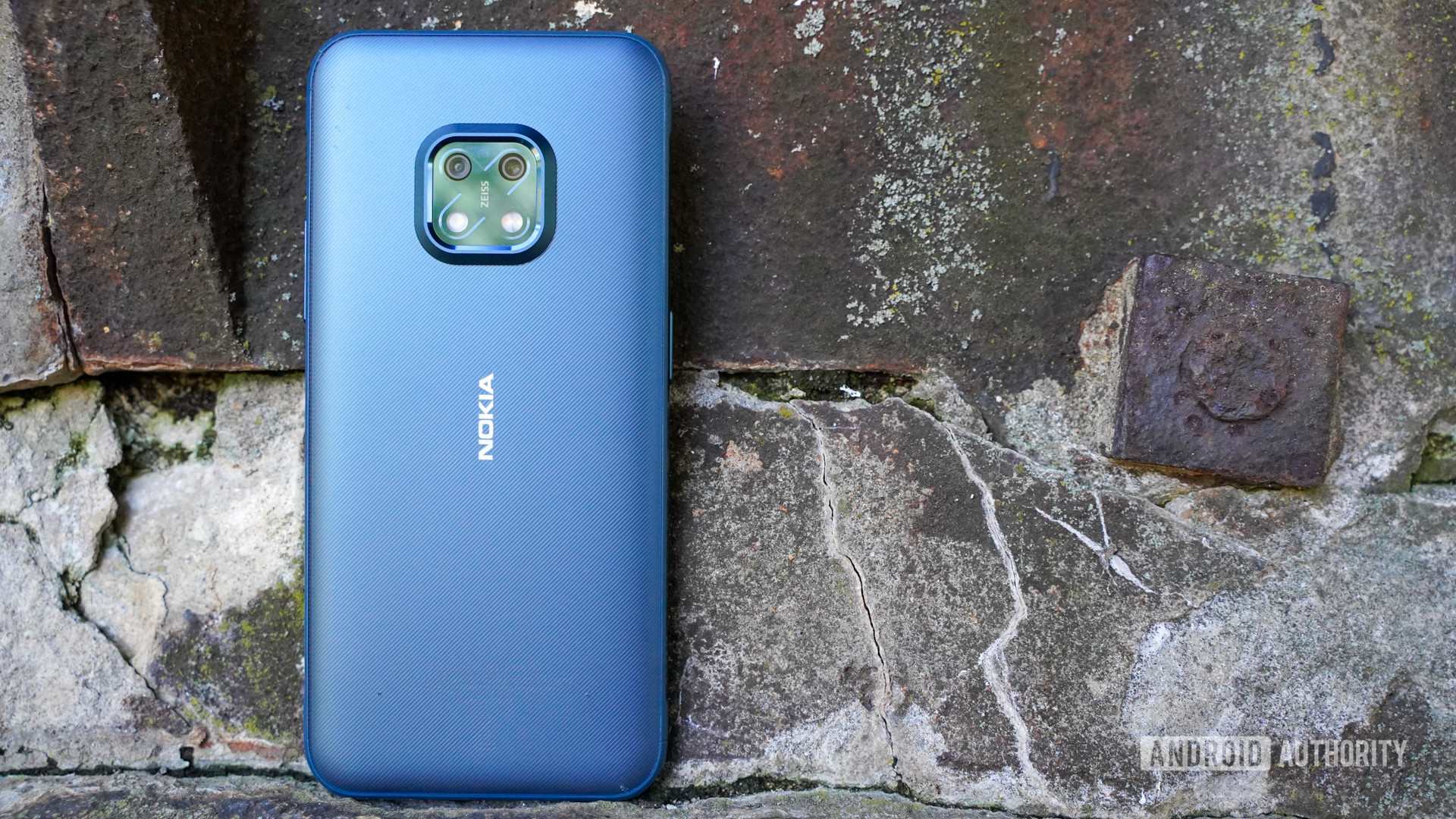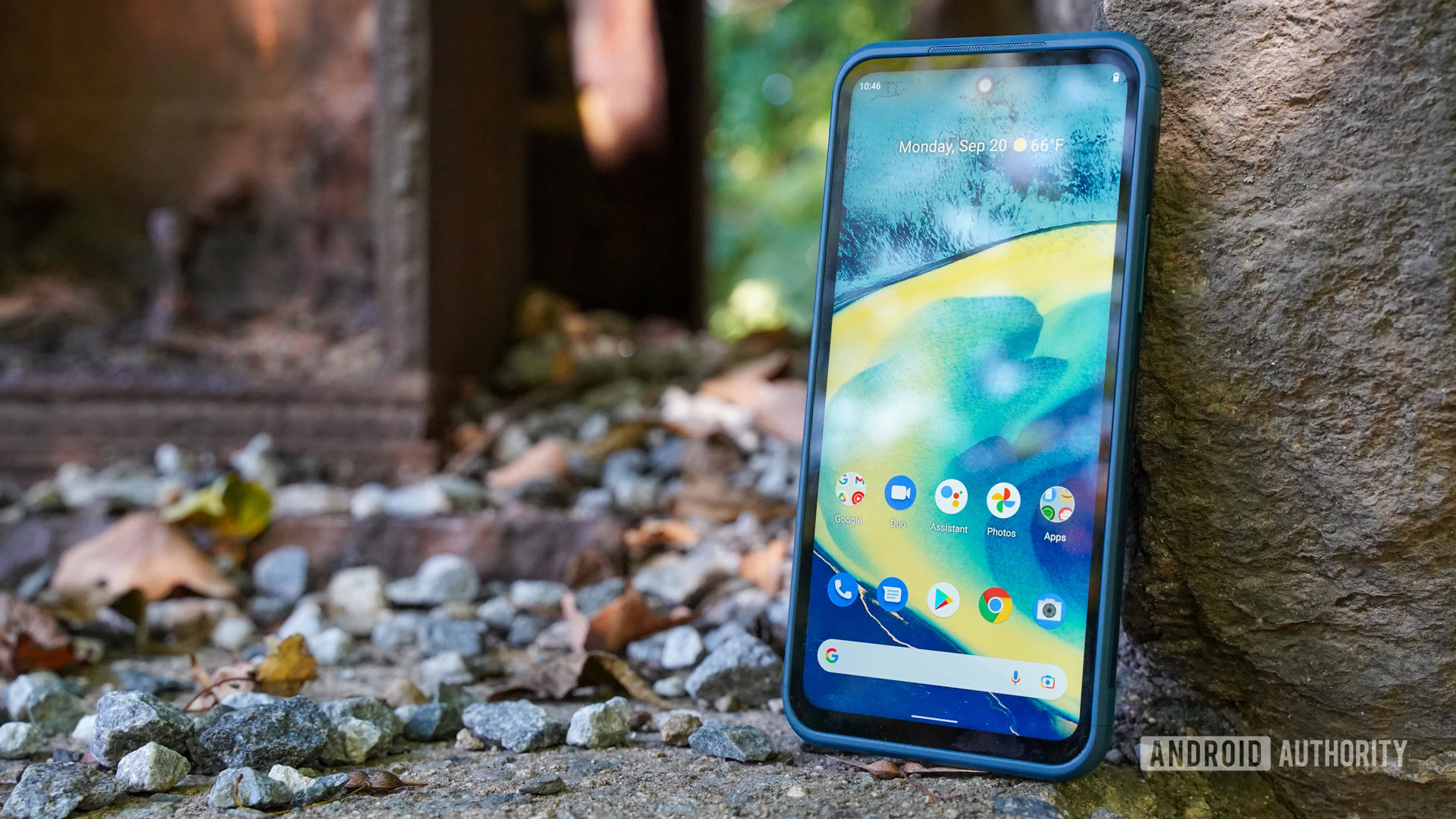A relatable rugged phone with few drawbacks
Nokia has always been renowned for the durability of its phones. Some of its classic handsets have been darned near indestructible. The Nokia XR20 from brand licensee HMD Global looks to honor that legacy, targeting those who need a toughened partner for their active lifestyle that’s also subtle in its strength. This is a rugged phone designed to be just as comfortable and appealing out on the town as it is out in the wilderness. Find out if this hardened handset is the ideal solution for you in Android Authority‘s Nokia XR20 review.
Related: The best rugged phones you can buy right now
What you need to know about the Nokia XR20
Eric Zeman / Android Authority
- Nokia XR20 (6GB, 128GB) US/UK: $549 / £449
- Nokia XR20 (4GB, 64GB) EU: €499
The Nokia XR20 is a rugged-styled smartphone that boasts a respectable spec sheet and somewhat svelte looks. It aims for maximum durability without resorting to the bulky hardware so often required for full protection. Its pricing falls in line with other rugged devices, which means it is an affordable way to buy into the market for tough phones. As its price point indicates, it’s more of a mid-range device and sits at about the middle of Nokia’s range in terms of performance.
Nokia sells two RAM/storage combos, which vary by region. The US and UK get the 6GB/128GB model while the rest of Europe gets the 4GB/64GB model. Both models support expandable storage. The phone comes in two colors: Ultra Blue (tested) and Granite. The device ships unlocked and supports the networks of AT&T and T-Mobile in the States, including 5G. It’s already available online from retailers such as Amazon and B&H Photo in the US, as well as Nokia direct.
What’s good?

Eric Zeman / Android Authority
There’s plenty to like about the Nokia XR20, starting with the hardware. Nokia did a commendable job designing a phone that looks good and acts tough.
The best way to think about the XR20 is as though it were a thin device with a tight case preinstalled. The phone has exposed aluminum side rails wrapped in a rubber coating around the outer edges and an aluminum chassis that’s covered in plastic on the rear. It’s big (171.64 x 81.5 x 10.64mm) and weighty (248g), but also reassuring. It comes across as much stronger than the average phone.
The phone meets the newer MIL-STD 810H for protection from drops, vibration, temperature extremes, and more.
How strong is it? In addition to the aluminum chassis, Corning’s top-grade Gorilla Glass Victus protects the display. The phone meets the newer MIL-STD 810H for protection from drops (from 1.8m), vibration, temperature extremes, salt humidity, and more. Of course, it scores an IP68 rating for protection against dust and water submersion (at a depth of 1.5m for up to one hour). These ensure that the phone should handle basic abuse with little worry. In order to test this, I threw the phone around my backyard, kicked it, dropped it to concrete, dunked it in the local river, and tossed it down my cellar stairs. It came away from these trials and tribulations none the worse for wear.
All of this is very impressive considering it doesn’t look like a typical bulky rugged phone, yet it combines some of the best protection ratings of any phone on the market.
You’d think a rugged phone would have minimum features, but the Nokia XR20 has more to offer than most flagships. In addition to a dedicated Google Assistant button, it has a user-programmable key, as well as a fingerprint reader, USB-C port, a headphone jack, a loop for lanyards, and extra loud stereo speakers. Those loud speakers are great for hearing speakerphone calls and blasting music in outdoor spaces.
The display is really nice. It measures 6.67 inches and offers FHD+ (2,400 x 1,080) resolution in a 20:9 aspect ratio. The screen pumps out 550 nits of brightness, which is enough for most scenarios though it was sometimes hard to see under direct sunlight. The selfie camera is centered at the top, punch hole style.
The 4,630mAh power cell pushes through two days of battery life with ease.
Battery life is outstanding. The 4,630mAh power cell pushes through two days of battery life with ease. Screen-on time measured in excess of eight hours. Moreover, the phone supports 18W wired charging (charger included) and 15W wireless charging. Re-charging times weren’t overlong, coming in at 85 minutes from empty. The wireless charging is a nice bonus.

Eric Zeman / Android Authority
Wireless support is excellent. The Nokia XR20 packs a fair number of 5G bands for both the US and the EU/UK (though no mmWave support). I tested it on T-Mobile’s 5G network in the US and came away impressed with speeds. The phone does not work with AT&T’s 5G network, but can access AT&T’s LTE network. Additionally, the XR20 includes Wi-Fi 6, Bluetooth 5.1 (with aptX Adaptive, aptX Voice), and NFC for mobile payments. That’s an impressive connectivity suite for this price range.
See also: The best smartphones running stock Android
Then there’s the software situation. The phone ships with Android 11, which runs smoothly on the device. It’s a clean build of stock Android and it has only a few bloaty apps, such as VPN Express and Spotify. More importantly, HMD Global has committed to three operating system upgrades and four years of security updates for the phone. You can’t ask for much more than that.
What’s not so good?

Eric Zeman / Android Authority
The Nokia XR20 has a lot going for it, but it’s not quite perfect. A few small things hold the phone back some and they are worth discussion.
First is performance. The XR20 ships with a Qualcomm Snapdragon 480 5G processor with an Adreno 619 GPU. HMD Global hasn’t specified what type of RAM and storage are on board. This is a SoC for entry-level phones. While the XR20 handled everyday tasks with relative ease, it doesn’t excel at everything. It got a little bogged down when I had lots of apps running in the background or when I loaded up a dozen tabs in Chrome. It certainly didn’t impress when running benchmarks. This is the type of chip you expect to find in phones costing $250 to $400. While you don’t expect stellar performance from a rugged-like phone, it’s a little disappointing for a phone that costs $550.
This is the type of chip you expect to find in phones costing $250 to $400.
Then there’s the camera. It’s not a bad system for the category, but again it should be a little better for the price point. The main shooter has a 48MP sensor at f/1.79 with autofocus while the ultra wide-angle camera has a 13MP sensor with fixed focus lens at f/2.4. Zeiss optics are on board, as are some Zeiss-branded shooting modes, including Zeiss Portrait and Zeiss Cinematic Effects. The shots I collected with the phone were average at best, and sometimes below average. I noticed a lack of detail here and there, and colors were often washed out. The 8MP selfie camera gets the job done, but delivers noisy results. Video capture is limited to 1080p at 60fps. The footage is just okay.
It should also be noted that unlike other rugged phones, you don’t get any photography hardware extras here. Other devices feature dedicated night vision modes and professional-grade thermal sensors.

Eric Zeman / Android Authority
Last, the fingerprint reader. The reader is built into the power button on the phone’s right edge. It’s simply not up to snuff. Not only is it hard to find, but its accuracy and speed are sorely lacking. You’re better off using a PIN or pattern to protect the phone. There’s face unlock for those that prefer, though it’s software-based so isn’t as secure.
Nokia XR20 camera samples
| Nokia XR20 | |
|---|---|
| Display | 6.67-inch FHD+ 2,400 x 1,080 20:9 aspect ratio Gorilla Glass Victus |
| Processor | Qualcomm Snapdragon 480 |
| RAM | 4GB or 6GB |
| Storage | 64GB or 128GB microSD card support up to 512GB |
| Power | 4,630mAh non-removable battery 18W wired charging support 15W wireless charging support |
| Cameras | Rear:
– 48MP main (ƒ/1.79, 1/2.25-inch sensor, 0.8μm, AF) Front: – 8MP main (ƒ/2.0, 1/4-inch sensor, 1.12μm) |
| Bands | GSM: 850, 900, 1800, 1900 | WCDMA: 1, 2, 4, 5, 8 LTE: 1, 2, 3, 4, 5, 7, 8, 12, 20, 28, 32, 38, 39, 40, 41, 42, 43, 66 5G4 SA+NSA: n1, n2, n3, n5, n7, n28, n41, n66, n77/n78 |
| Connectivity | Wi-Fi 802.11 b/g/n/ac/ax Bluetooth 5.1 NFC support |
| Ports | USB-C port 3.5mm headphone port Dual-nano SIM slot OR Nano-SIM and microSD card slot |
| Security | MIL-STD 810H certified 1.8m drop protection IP68 certified |
| Buttons/sensors | Power/fingerprint sensor Volume rocker Google Assistant button Top-mounted customizable button |
| Software | Android 11 |
| Dimensions/weight | 171.6 x 81.5 x 10.6mm 248g |
| Colors | Ultra Blue Granite |
Nokia XR20 review: Should I buy it?

Eric Zeman / Android Authority
HMD Global dialed in a good mixture of features and performance in the Nokia XR20, though it is not without its faults. The basic design is solid, with appealing looks and capable hardware. Its MIL-STD 810H and IP68 ratings ensure that the phone handles a fair amount of abuse in unforgiving environments — and it lived up to that in our testing. The large display is bright and contrasty with the benefit of Gorilla Glass Victus protecting it. Other essentials including excellent battery life, rapid charging speeds, solid 5G wireless support, and extra loud speakers round out the experience.
We didn’t expect the Nokia XR20’s camera to deliver pure gold results, but we were hoping for sharper, more colorful images, especially considering there aren’t extra sensors for specialist workers. Perhaps most importantly, the entry-level processor, while enough to handle everyday tasks, might slow down with age and software updates over time.
The Nokia XR20 is a relatable ruggedized smartphone that doesn’t look out of place in the boardroom or the boondocks.
All that said, none of the rugged phones tested by Android Authority covers everything perfectly. Each has pros and cons that you have to weigh before making a purchase. The Cat S62 Pro ($649) is an excellent, full-fledged rugged device with extras like a Flir heat camera, but you’ll pay for that specialization. Similarly, the Kyocera DuraForce Ultra ($899) is a chunker of a device with better performance specs but a higher price tag to match and questionable software support. The Samsung Galaxy XCover Pro ($499) is the closest to the Nokia XR20 in terms of price, features, and design, but packs an even more underpowered chipset.
The Nokia XR20 is a relatable ruggedized smartphone that doesn’t look out of place in the boardroom or the boondocks. If you want a normal-looking phone with excellent battery life that happens to be tough, the XR20 covers the bases well. If you’re looking for camera extras, better performance, or an even more durable build, take a look at the competition first.

Nokia XR20
Nokia XR20
The Nokia XR20 is a semi-rugged phone that can handle drops and spills while offering two-day battery life, a large display, and fast 5G data service.
For all the latest Technology News Click Here
For the latest news and updates, follow us on Google News.
